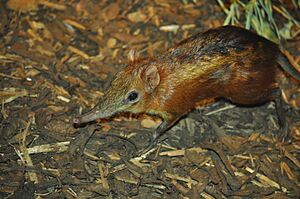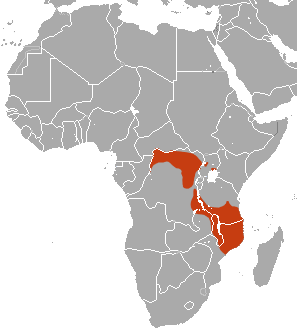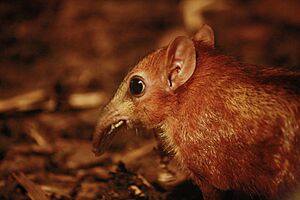Chequered sengi facts for kids
The Chequered sengi (also known as checkered sengi or checkered elephant shrew) is a unique animal. It looks a bit like a small deer but is actually related to elephants! It belongs to the elephant shrew family, Macroscelididae. Its scientific name is Rhynchocyon cirnei.
Quick facts for kids Checkered elephant shrew |
|
|---|---|
 |
|
| Conservation status | |
| Scientific classification | |
| Genus: |
Rhynchocyon
|
| Species: |
cirnei
|
 |
|
| Checkered elephant shrew range | |
Contents
What Does the Checkered Sengi Look Like?
Checkered sengis are quite long for an elephant shrew. They can grow to be about 25 to 30 centimeters (10 to 12 inches) long. This measurement does not include their tail. Their tail is usually a little shorter than their body, around 25 centimeters (10 inches).
These animals commonly weigh about half a kilogram (1.1 pounds). Some can even grow to be around 0.7 kilograms (1.5 pounds). Their fur is usually light to medium brown. It can also be beige or dark brown. They have a special "checkered" pattern on their back. This pattern is made of alternating chestnut and lighter colors. Checkered sengis also have darker stripes on the sides of their body.
Where Do Checkered Sengis Live?
The checkered sengi lives in several countries in Africa. These include the Democratic Republic of the Congo, Malawi, Mozambique, Tanzania, Uganda, and Zambia. They might also live in the Central African Republic.
They like to live in different kinds of natural areas. These include dry forests, moist lowland forests, and moist mountain forests. They can also be found in dry shrublands. Sadly, their homes are shrinking because of habitat loss. This means their natural living areas are being destroyed or changed.
How Do Checkered Sengis Behave?
Checkered sengis are known to mate for life. This means a male and female sengi will stay together as a pair. They work together to defend their territory. This territory can be a few acres large.
What Do Checkered Sengis Eat?
The checkered sengi is mainly an insectivore. This means it mostly eats insects. Its favorite foods include termites, ants, beetles, and centipedes. They also eat other small creatures. These can include mollusks, eggs, and small mammals. Sometimes, they will even eat small amphibians and birds.



